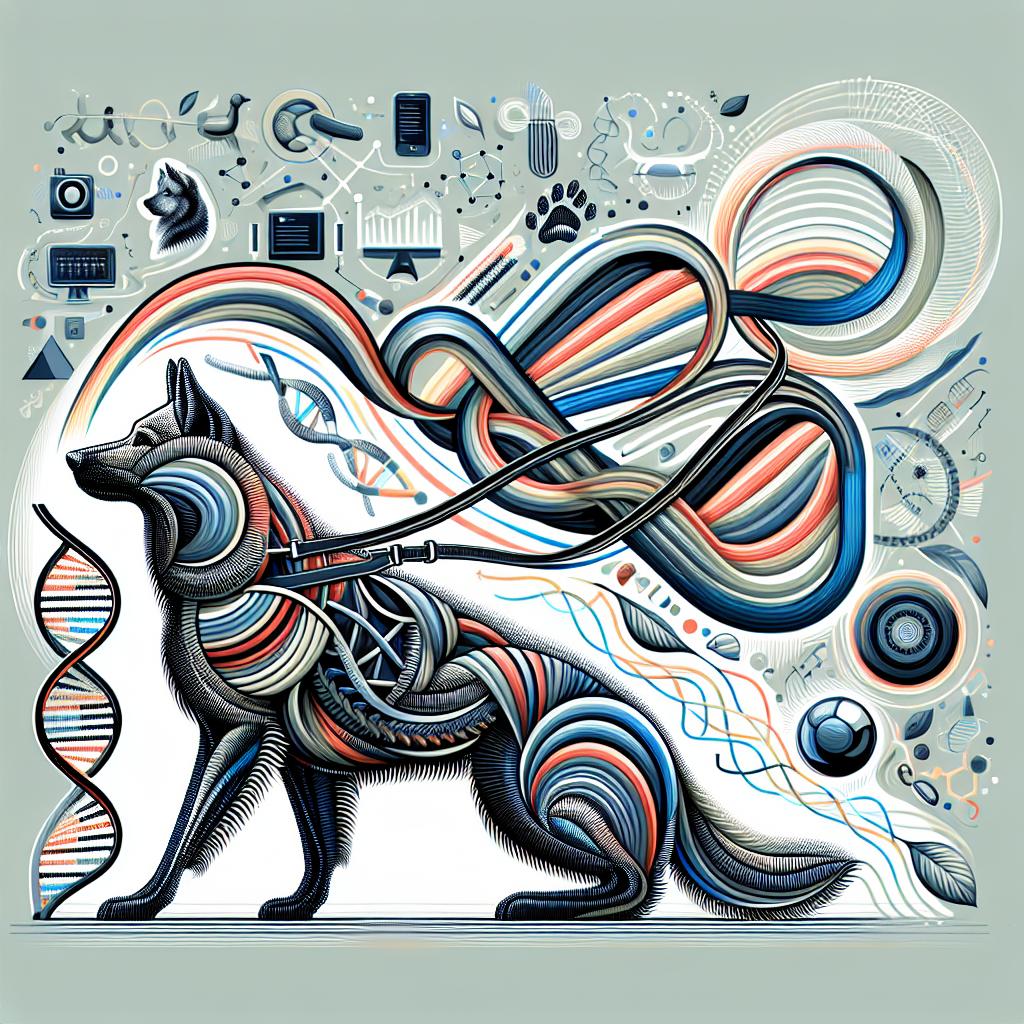Addressing Leash Reactivity in Dogs: A Path to Peaceful Walks
Imagine stepping out your front door, the sun casting a warm glow as you prepare for a delightful stroll with your canine companion. The air is fresh, the birds are singing, and you’re ready to embrace the world outside. Then, suddenly, a rush of tension shoots through the leash as your dog lunges and barks at a passing squirrel, another dog, or even a passerby. What should have been a moment of joy instead morphs into a whirlwind of stress and frustration.
Leash reactivity is a common issue faced by many dog owners, transforming everyday walks into anxiety-laden experiences. But rather than resigning to this challenging behavior, understanding the roots of leash reactivity can pave the way for a harmonious relationship between you and your furry friend. In this article, we’ll explore the causes of leash reactivity, share compassionate strategies for addressing it, and empower you with the tools necessary to transform your walks into serene adventures. Join us on this journey to uncover the techniques that can help you and your pup reclaim the joy of exploration together.
Understanding the Roots of Leash Reactivity in Dogs
Leash reactivity in dogs often stems from a complex combination of emotional, environmental, and genetic factors. Understanding these roots can offer valuable insights into why a seemingly well-behaved dog can suddenly become reactive when restrained. Fear, frustration, and overexcitement are some of the primary emotions that trigger this behavior. When dogs are on a leash, their natural instincts may conflict with their desire to explore, meet other dogs, or investigate their surroundings, leading to confusion and anxiety that manifests as reactivity. Additionally, early experiences and socialization play crucial roles in shaping a dog’s behavior; a lack of exposure to various stimuli can result in heightened stress reactions later in life.
Identifying the specific triggers that contribute to a dog’s leash reactivity is essential for effective intervention. Common factors include:
- Strangers or other dogs: Dogs may react defensively when they perceive a threat or competition.
- Loud noises: Sudden or unexpected sounds can incite fear, causing an instinctive response.
- Unfamiliar environments: New terrains can lead to anxieties that dogs express through reactive behavior.
By mapping out these triggers, owners can adopt a more tailored approach to training and desensitization, which can significantly enhance their dog’s ability to cope with stressors encountered while on a leash.

Effective Training Techniques to Mitigate Reactive Behavior
To effectively address leash reactivity, it’s essential to implement a variety of training techniques that prioritize the dog’s comfort and gradually desensitize them to their triggers. One effective method is counter-conditioning, which involves changing your dog’s emotional response to the stimuli they react to while on a leash. For instance, when your dog sees another dog, you can reward them with treats or praise as long as they remain calm and below their threshold of reacting. Timing is critical here, as rewards should be given immediately upon observing the desired behavior. Additionally, it is beneficial to work on engagement exercises where you teach your dog to focus on you rather than their triggers. This can be achieved through practices such as named recalls or the use of toys to redirect their attention.
Another powerful technique is habituation, which entails gradually exposing your dog to their triggers from a safe distance. This helps them become accustomed to the presence of other dogs without feeling overwhelmed. Start in a controlled environment, and as your dog shows less reactiveness, slowly reduce the distance between them and the trigger. For a comprehensive approach, consider keeping a training log to monitor progress and setbacks. Below is a simple table that outlines some common training techniques alongside their objectives:
| Technique | Objective |
|---|---|
| Counter-conditioning | Change negative associations with triggers |
| Engagement exercises | Teach focus and minimize distractions |
| Habituation | Desensitize to triggers at a safe distance |

Creating a Positive Walking Environment for Your Dog
Creating a welcoming atmosphere during walks can significantly ease the stress associated with leash reactivity in dogs. It’s essential to choose environments that promote safety and comfort. Consider early morning or late evening strolls when there are fewer distractions like other animals or loud sounds. Look for pathways that provide ample space for your dog to feel secure, and avoid congested areas that may lead to heightened anxiety. Additionally, having a selection of your dog’s favorite toys or treats on hand can help redirect their focus when encountering triggers.
Establishing a positive ritual can also contribute to a relaxing walking experience. Incorporating interactive elements such as:
- Engaging toys during pit stops
- Frequent praise for calm behavior
- Short training sessions throughout the walk
can reinforce good behavior and transform walks into enjoyable outings. Creating a predictable routine enhances security and assists dogs in managing their reactions to other animals or stimuli. Furthermore, connecting with fellow dog walkers who are understanding can foster a sense of community and support, ultimately contributing to a more positive walking environment for both you and your pet.

The Role of Consistency and Patience in Overcoming Reactivity
In the journey to address leash reactivity, the twin virtues of consistency and patience forge a path towards success. Consistency refers to the unwavering commitment to a training plan that aligns with your dog’s needs. This involves ensuring that every family member is on the same page regarding commands, rewards, and responses to reactivity. Inconsistencies can lead to confusion and mixed signals, derailing progress. Patience, on the other hand, acts as a steady hand guiding both the handler and the dog through the learning curve. Reactivity is a behavior that has often developed over time, and unlearning it will not be an overnight affair. Taking the time to recognize small triumphs can make the process more fulfilling for both dog and owner.
To cultivate these qualities in your training routine, consider employing the following strategies:
- Establish a Schedule: Create regular training sessions that fit seamlessly into your daily routine to build a habit.
- Set Achievable Goals: Break down the training process into smaller milestones to track progress effectively.
- Use Positive Reinforcement: Reward desired behaviors immediately to reinforce learning and encourage repeat actions.
Here’s a simple table to visualize the benefits of consistency and patience in training:
| Aspect | Benefits |
|---|---|
| Consistency | Builds trust and clarity for the dog, creating a safe learning environment. |
| Patience | Allows time for understanding and adaptation, reducing frustration for both parties. |
Q&A
Q: What is leash reactivity in dogs?
A: Leash reactivity is a behavioral response exhibited by dogs when they are on a leash and encounter other animals, people, or distractions. This reaction can manifest as barking, lunging, growling, or attempting to escape. It’s a way for dogs to express excitement, fear, or frustration, but it can make walks stressful for both the dog and the owner.
Q: What causes leash reactivity in dogs?
A: Several factors can contribute to leash reactivity, including lack of socialization, fear of other dogs or people, frustration at being restrained, or simply an innate instinct to protect territory. Each dog is unique, so the underlying cause may vary from one individual to another.
Q: How can I identify if my dog is leash reactive?
A: Look for signs such as intense barking, lunging towards another dog or person, growling, or even freezing in place while staring. Your dog may also display increased muscle tension on the leash or may be unable to focus on you. Recognizing these behaviors early can help you implement strategies to manage the reactivity.
Q: What steps can I take to address my dog’s leash reactivity?
A: Start with desensitization and counter-conditioning. Gradually expose your dog to triggers from a distance they can manage and reward calm behavior with treats or praise. Positive reinforcement plays a crucial role. Training in a controlled environment, using techniques like “sit,” “stay,” or “leave it,” can also help create new, positive associations while on the leash.
Q: Should I seek professional help for my dog’s leash reactivity?
A: If your dog’s reactivity feels unmanageable or is causing concern for you or others, seeking help from a professional dog trainer or behaviorist can be beneficial. They can provide tailored strategies and support based on your dog’s specific needs, ensuring a safe and positive learning environment.
Q: How important is socialization in addressing leash reactivity?
A: Socialization is immensely important. Regularly exposing your dog to various environments, people, and other dogs can help decrease anxiety and build confidence. When done correctly, socialization fosters positive interactions, allowing your dog to learn appropriate responses and behaviors.
Q: Can leash reactivity be completely eliminated?
A: While some dogs may learn to manage their reactivity effectively, it’s important to remember that reactions can vary based on the situation. The goal isn’t necessarily to eliminate the behavior but to redirect it towards a more controlled and calm response. Consistent training and patience are key components in this journey.
Q: How can I maintain my dog’s progress in reducing leash reactivity?
A: Continue regular training sessions, engage in controlled exposure to triggers, and reinforce calm behaviors with treats or praise. Keep walks enjoyable by integrating play and exploration, ensuring they remain fun and stress-free. Remember to celebrate small victories – consistency breeds success!
These Q&As provide a nuanced understanding of leash reactivity in dogs, empowering owners to tackle this common issue compassionately and effectively.
In Summary
In wrapping up our exploration of leash reactivity in dogs, it’s important to remember that every journey begins with understanding. As we navigate the complexities of canine behavior, we uncover not only the challenges but also the potential for deeper connections with our furry companions. Addressing leash reactivity is not merely about managing a behavior; it’s about forging a path towards trust, communication, and mutual respect.
With patience, consistent training, and a sprinkle of compassion, we can transform those anxious barks into calm interactions. Each dog is unique, and while the road to improvement may twist and turn, the rewards are manifold—enriching walks, peaceful outings, and the joy of seeing our dogs thrive in a world filled with new sights and sounds.
So, as you step into your next walk, let this knowledge empower you. Equip yourself with the strategies we’ve discussed, and embark on this adventure with an open heart and a spirit of collaboration. Together, we can turn leash reactivity into a stepping stone toward a harmonious partnership between you and your four-legged friend. After all, the leash is not just a tether; it’s a bridge connecting two worlds, and together, you can journey toward greater understanding and joy.

